Most birds of prey are fast, large, and have sharp beaks and talons or all of the above. The wild birds on this list live in North America and have a reputation for being dangerous.
Remember that most of the time, there’s a good reason behind the aggression shown by a bird or another type of animal. It could be defending its young or searching for food in order to stay alive.
Look at eight birds living in North America that are considered dangerous to other animals or humans in certain situations.
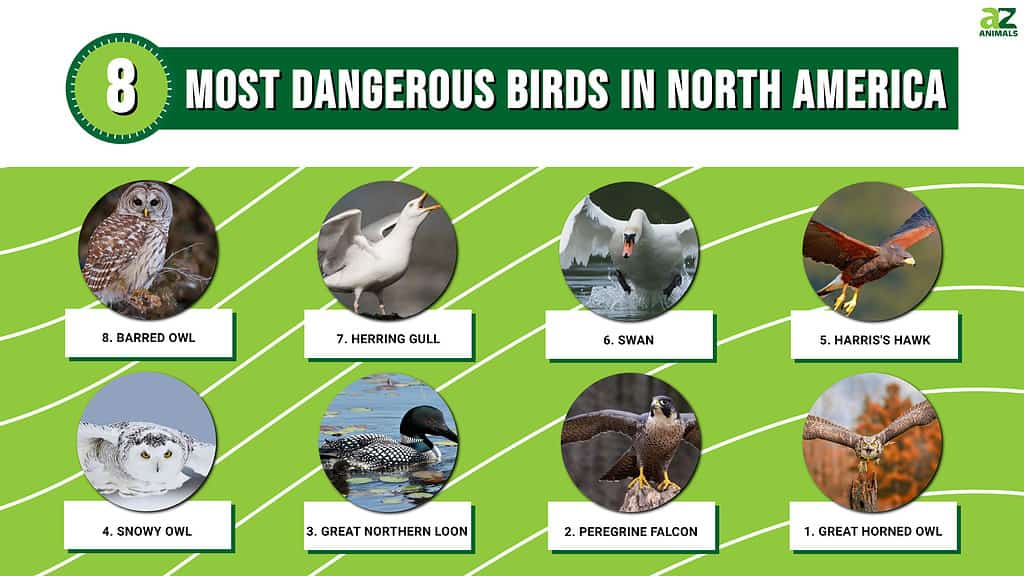
8. Barred Owl

Barred owl, Strix varia, perched on a branch in winter in Canada.
©Jim Cumming/Shutterstock.com
Barred owls live in woodland and swamp habitats over the eastern half of the United States. Pairs of barred owls hooting at one another is a common sound in the swamps of Florida and Georgia. It hunts for mice, squirrels, rabbits, lizards, and even insects. Its silent, fast rate of flying speed and sharp talons are what landed it on the most dangerous birds of North America list.
The barred owl sits high up on a branch in a swamp or woodland. It uses its first-rate owl vision to scan the ground for prey. When it sees a small mammal or reptile, it takes off. This owl is an expert at flying low to the forest floor in pursuit of prey. It stretches out its talons and grabs the small animal as it tries to get away.
To learn more about the barred owl, look here.
7. Herring Gull
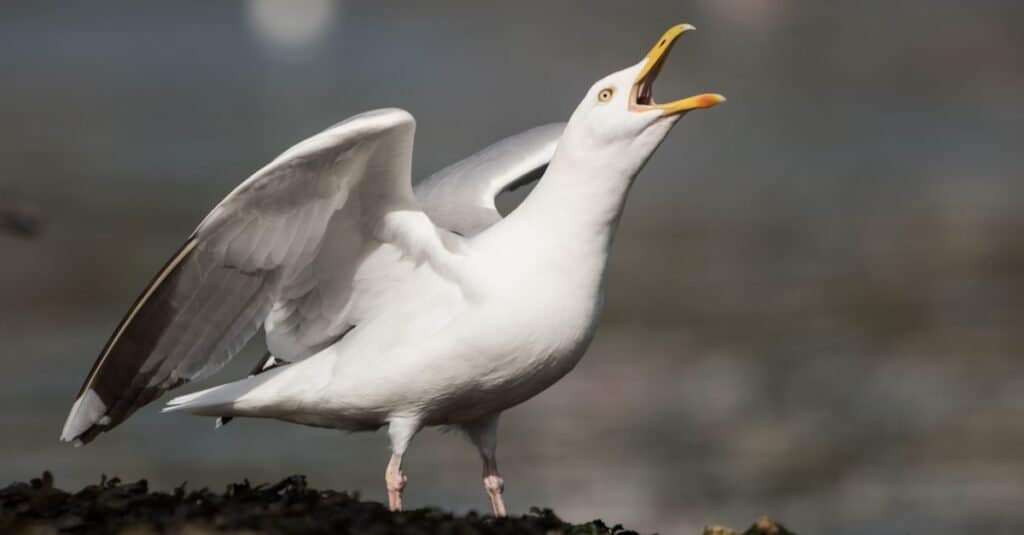
©Maciej Olszewski/Shutterstock.com
Herring gulls are on the most dangerous birds in North America list for a few reasons. Their combination of boldness and sharp beaks make them potentially dangerous to both animals and humans.
The natural diet of this bird includes fish and crustaceans. Not surprisingly, they’re attracted to the foods people bring to beaches and shorelines. Today, as more people are spending time on the beach, these birds have become bolder in their attempts to steal food.
A person who tries to get a sandwich or piece of food away from a herring gull is at risk of being cut by this bird’s very sharp beak. Not only do they try to steal food from people, but they also try to take it from other birds.
Though one herring gull may not be an issue, they can form very large groups in a short amount of time. So, it’s best to keep your distance from these birds, and definitely don’t share your lunch!
6. Swan

©Tone Trebar/Shutterstock.com
Dangerous is not likely to be the first word that comes to mind when you picture a swan. These birds are known for their bright white feathers and graceful swimming. But it turns out swans can be dangerous birds if they feel threatened.
Swans are territorial. They live near lakes, ponds, and marshes. If a human or another animal gets too close to a swan’s nest of eggs or young, this bird hisses, flaps its wings, and fluffs up its feathers to appear even bigger. Though it doesn’t have teeth, a swan can use its beak to viciously snap at a person or an animal. This can tear clothes, pinch, or even cause bruises. One of the most dangerous things about them is they won’t stop chasing an intruder until they are well out of the bird’s territory.
Study more about swans here.
5. Harris’s Hawk
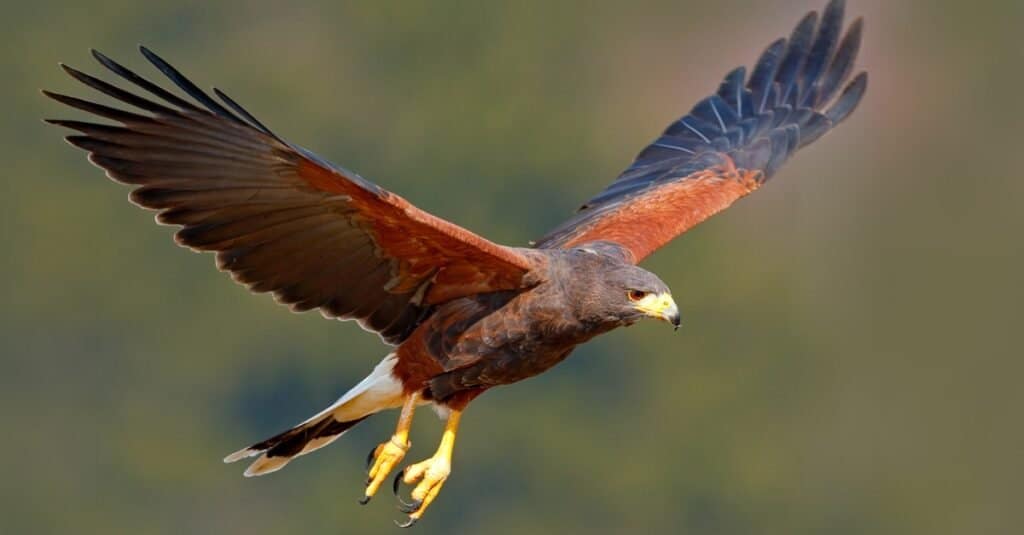
©Ondrej Prosicky/Shutterstock.com
Like most hawks, Harris’s hawk is a fast, agile flier. Though it is smaller than most hawks, it possesses strong talons to grip its prey on small birds and mammals. But there are a few things that make Harris’s hawk different from other birds of prey.
While most hawks are solitary hunters, Harris’s hawks hunt in groups. In fact, there may be as many as nine hawks chasing down one mouse, pigeon, or other prey. A couple of hawks chase the prey away from their shelter. Other hawks in the group move the prey toward the remaining members of the group where it is captured.
Harris’s hawks form groups when trying to drive away another bird or a predator. They dive and claw at the intruder until it moves off or is injured. While one Harris’s hawk may not seem like a threat, a group of them definitely can be threatening!
To learn more about Harris’s Hawk, go to this page.
4. Snowy Owl
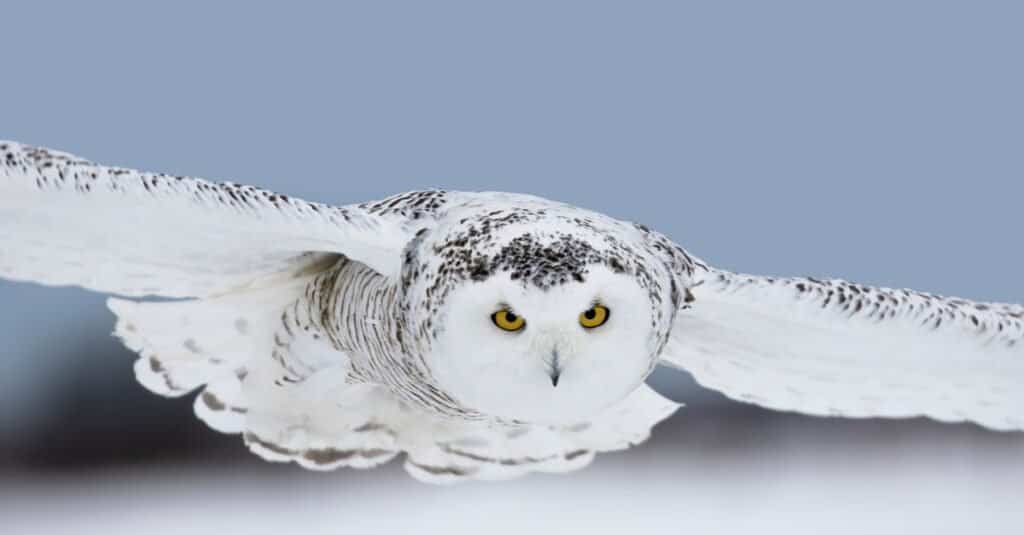
©Jim Cumming/Shutterstock.com
The snowy owl is best known for its white feathers featuring a spray of small dark spots. Its white feathers help it to blend with its snowy habitat in the Arctic tundra. Lemmings are the main diet of these birds of prey. Snowy owls also eat mice, small birds, and fish. These silent hunters possess a combination of speed, intelligence, and strength.
This owl remains on a tree branch or other perch while using its eyes and ears to look for prey below. It can even hear the rustling of a mouse. When it sees a lemming or other small animal, it swoops to the ground picking up the prey with a whoosh of its wings. Though they have white feathers that partially cover their feet, snowy owls have razor-like talons. Once they grab onto a lemming, mouse, or snake, it’s time to eat!
Find out more about the snowy owl right here.
3. Great Northern Loon

©Rejean Bedard/Shutterstock.com
It may be surprising to see a loon on a list of the most dangerous birds in North America. After all, aren’t they just as harmless as ducks? Well, the great northern loon may look like a duck, but it has the potential to be very dangerous.
The diet of a great northern loon consists mostly of fish along with some crustaceans, reptiles, and amphibians. Once a loon sees a fish, frog, or salamander, it uses its great speed to dive and chase it. This bird stabs the prey with its pointed beak, then swallows it whole!
Since these birds spend time in lakes and on the coastlines of North America they occasionally cross paths with swimmers. This is another reason why the great northern loon is on the most dangerous bird list. If a loon feels its young or its territory is being threatened, this bird can use its pointed beak as a weapon on a human. Though the person means no harm to the bird or its young, the loon will try to protect its territory.
Find more on the great Northern loon here.
2. Peregrine Falcon
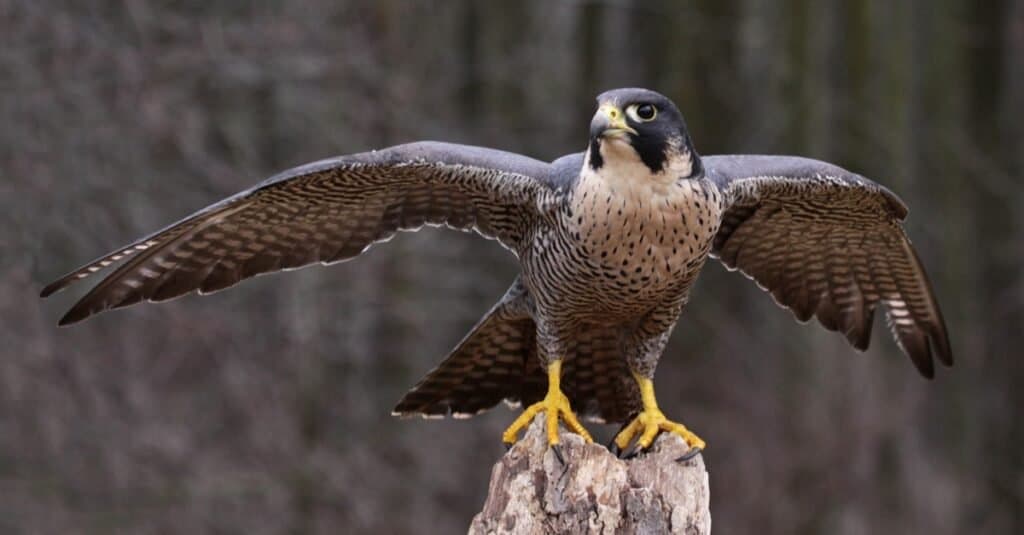
©Chris Hill/Shutterstock.com
Take one look at the sharp, bright yellow talons of the peregrine falcon and you’ll know why it’s on this list. The prey of this falcon includes smaller birds such as doves, pigeons, songbirds, and wading birds. The peregrine falcon uses its excellent vision to scan fields and forests from high in the air. When it spots a small bird, it flies closer and prepares to attack. But the sharp talons of this falcon are only a part of what makes it dangerous to its prey.
A peregrine falcon can dive for prey at a speed of 200mph or more! These birds of prey can maneuver with ease through trees and tall weeds. It doesn’t take long for the peregrine falcon to catch up with its prey and grasp it with sharp talons. If the falcon is a mother hunting food for her chicks she’ll tear the prey apart with her hooked beak and give pieces to her young. Peregrine falcons live in all parts of the United States.
Read this page for more on the majestic peregrine falcon.
1. Great Horned Owl
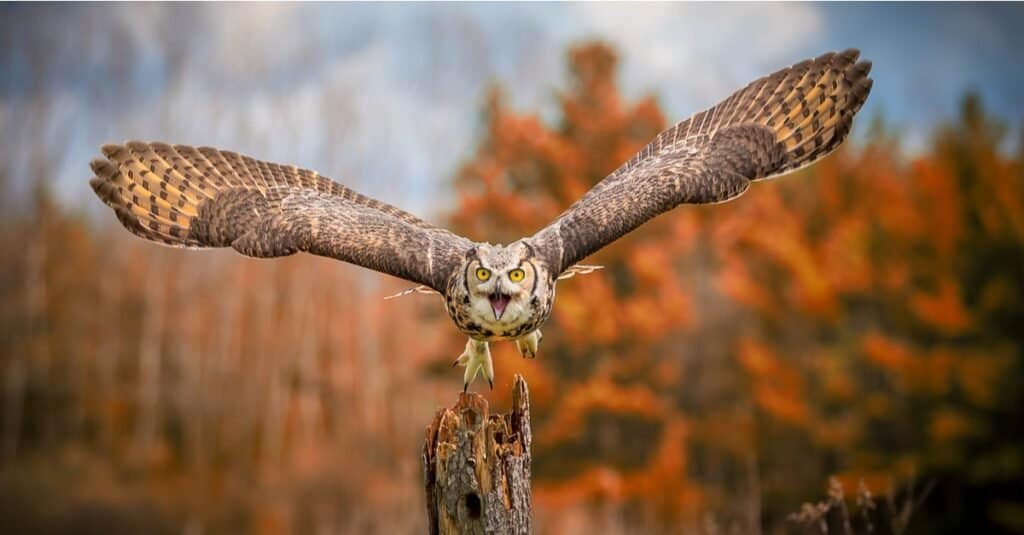
©Imran Ashraf/Shutterstock.com
The great horned owl is easily recognizable by the two tufts of feathers that stand up on its head like horns. Though these tufts of feathers are a cute feature, this owl is all business when it’s hunting for prey. In fact, it carries the nickname, tiger of the air.
This owl hunts at dusk or after the sun goes down. But, instead of flying around in search of food like other birds of prey, the great-horned owl sits in a tree and scans the area. It has superb hearing and eyesight. When it sees a mouse, rabbit, snake, or toad, it silently lifts off from its tree branch. From there, it swoops over the ground and grabs the prey with its talons.
This is one of the most dangerous birds because of its talons, curved sharp beak, and its aggressive way of hunting. This owl has been known to try to capture a porcupine! Great horned owls live in forests, swamps, fields, and deserts throughout North America.
Check out more on the great horned owl by visiting this page.
Summary of the 8 Most Dangerous Birds in North America
Here is a list of the 8 most dangerous birds in North America:
| Rank | Bird |
|---|---|
| 1 | Great Horned Owl |
| 2 | Peregrine Falcon |
| 3 | Great Northern Loon |
| 4 | Snowy Owl |
| 5 | Harris’s Hawk |
| 6 | Swan |
| 7 | Herring Gull |
| 8 | Barred Owl |
Honorable Mentions: Other Dangerous Birds in North America
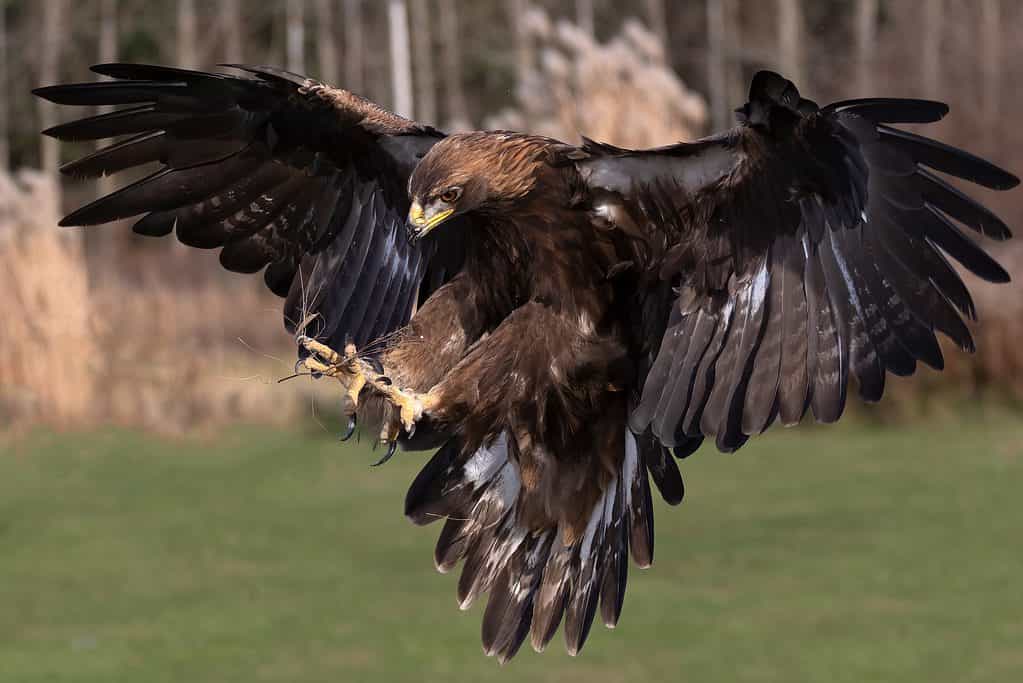
Golden eagles are powerful enough to kill a man, although there are no incidents of this ever occurring.
©Touched by light images/Shutterstock.com
When one thinks of birds, there can be many different interpretations of danger – will their large talons and sharp beaks cause damage? Are they poisonous to ingest? The answer to both of these questions is yes and depending on the species, like the Golden eagle or the red-tailed hawk, you may suffer from a talon attack, although this is extremely rare for humans, or the ruffed grouse, who, thanks to their propensity for ingesting poisonous plants, can make those who consume them extremely ill. Read on for more information:
- Red-shouldered hawk (Buteo lineatus) – unlike many birds, this raptor is not wary of humans, and much like the red-tailed hawk, will attack if you are too close to its nest. There are even reports of this bird terrorizing residents in a Connecticut town. This is a medium-sized bird that has a wingspan of up to 40 inches, and a length of up to 24 inches, with females being larger than males.
- Ruffed Grouse (Bonasa umbellus) – this is one of the most popular game birds and is often confused with pheasant. However, this bird was once responsible for a large quantity of poisonings and even a few deaths during the 18th and 19th centuries. During the winter months, these birds are known to consume mountain laurel buds that are poisonous to humans but are perfectly safe for them. It is believed that once hunting was relegated to the fall, rather than year-round, the cases of toxic ingestion were eliminated.
- Red-tailed hawk (Buteo jamaicensis) – these hawks are considered forest raptors, and can be found in mixed deciduous–conifer forests and deciduous swamps. With an impressive wingspan of almost four feet, they typically avoid humans but can be dangerous during nesting season. They are known to dive into those who wander too close and can inflict serious damage. Their eyesight is exceptional and they can reach speeds of up to 120 miles per hour.
- Golden eagle (Aquila chrysaetos) – this impressive raptor is not only one of the largest birds found in North America, with a wingspan of over seven feet, but they are incredibly fast, capable of reaching speeds of up to 200 miles per hour. Their talons are almost three inches long and combined with a grip strength of up to 400 psi, they are 10 times stronger than an average human adult. Even though there are reports of them snatching children, there are no confirmed accounts of this. While they generally won’t attack humans, should you wander too close to their territory and nests, they will use their talons to inflict damage.
The photo featured at the top of this post is © Jeffrey P Miller/Shutterstock.com
Thank you for reading! Have some feedback for us? Contact the AZ Animals editorial team.






